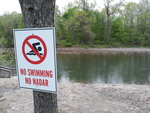

Esopus Creek, home of the Marbletown Park beach, is still not safe for swimming, according to June and July water quality tests.
In May, Marbletown employees decided to tentatively close the town beach for swimming this season, given the beach had been closed so much in 2018 due to poor water quality.
"We were only allowed to open eight days the entire (2018) season," Marbletown supervisor Rich Parete said in May. "There's no reason to believe that the water quality is to be better this year."
In fact, June and July test results both showed high bacteria counts – 980 and 272 cells of bacteria, respectively. The counts are the number of cells per 100 milliliters of water tested. These tests were done by Riverkeeper, an environmental organization focused on the Hudson River and its tributaries.
The Riverkeeper website, www.riverkeeper.org, lists counts from 0 to 60 cells as "acceptable," and anything above 60 as "beach advisory." The test looks for enterococcus counts.
"Enterococcus (“Entero”) is a fecal indicating bacterium that lives in the intestines of humans and other warm-blooded animals. It is the EPA preferred indicator for sewage contamination," according to the website for Riverkeeper.
Esopus Creek water quality problems have gotten worse in recent years, according to Riverkeeper data, which is available back through 2012. While the levels had been testing "acceptable" during the summer swimming season, this changed in 2016, and the condition has persisted ever since.
The entire lower Esopus Creek had been generally safe for swimming, said Dan Shapley, water quality program director for Riverkeeper. "Since 2016 (we've observed) a real decline in water quality."
He specified it was particular to the Esopus, as opposed to a more widespread problem affecting other area waterways. For example, Riverkeeper data for the Rondout Creek in High Falls near the D&H Canal has been more consistent, albeit consistency regarding high bacteria counts. For example, from 2012 to the present, the only July tests that showed "acceptable" levels of bacteria (60 or fewer cells) at that site were in 2015 and 2017. All other years' July tests showed results above the threshold.
"It's unique in our study area to see this kind of dramatic change in water quality," Shapley said of the Esopus. "We're very curious about it, and we're eager to see the problems identified and solved."
Possible causes and further study
As to possible causes, Shapley said it can be tough to figure out.
"There are techniques for trying to identify sources. But I'll be honest. We've struggled with this. It is … (a) challenging task, but I think it is an important one where you have a swimming beach that people really love and want to jump into on a hot day," he said.
He listed potential problems that could be contributing to the problem.
"Several issues may be responsible for the decline in water quality we have observed, including (but not limited to) failing septic systems, wildlife, and the operation of the reservoir," Shapley said later in an email. "Failing septic systems and wildlife may be sources of bacteria, while sediment and water levels influenced by reservoir operation may affect the persistence and transport of bacteria in the creek," he wrote.
Shapley said a general rule of thumb is that about 10 percent of septic systems, countrywide, are failing.
"The assumption is many septic systems are old and inadequate," he said.
And if part of the problem is waters being released from the Ashokan Reservoir, it wouldn't be the first time this has been an issue.
In 2013, a settlement following unauthorized water releases from the reservoir required New York City to provide Ulster County with $200,000 to conduct a stream management study of the Esopus. Among other requirements, the city was also required to do an environmental impact study (EIS) on various ways of managing water from the Catskill Water Supply System.
Shapley said the city's EIS may soon be completed. As to the county management plan, he said he understood the county was waiting for the results of the EIS before moving forward.
"I'm very interested in seeing that project move along so that towns like Marbletown and people who want to visit the beach … can benefit from the money that's been set aside for a creek study and a management plan," Shapley said.
As to day-to-day usage of the creek, Shapley specified the test results can change over short periods of time. The results are, rather, an indication of increased risk.
"This doesn't mean that you can't touch the creek on a given day. It means our level of trust in the water quality is much diminished based on the recent data," Shapley said.
For more information, see the Riverkeeper website, www.riverkeeper.org.
Below is a story previously posted on June 8, 2019
After last year’s season, where the beach was open for only eight days, Marbletown employees have tentatively decided not to open the town beach this summer.
"It's not fair for the community, it's not fair for the lifeguards, to be open two days here, one day there," town supervisor Rich Parete said. "Being open eight days in the entire season ... it's just not a good situation."
Parete said the Ulster County Health Department periodically tests public swimming areas.
"We were only allowed to open eight days the entire (2018) season," he said.
"There's no reason to believe that the water quality is going to be better this year," Parete said. "It [contamination] was either from farms or leaky septics."
However, Parete said, the water will still be tested this year.
"We can reevaluate it if it looks safe," he said.
Parete said people could still go sit on the beach, and that the area would still be open to fishing.
"You just can't be in the water," he said.